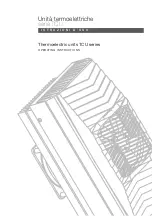
1. INTRODUCTION
The Heeve Commercial-Series Forklift Dock Ramp / Yard Ramp (hereinafter “yard ramp” for short) is a
manually operated dock leveller to bridge the difference in height between the vehicle loading bed and the
ground surface where a permanent loading platform isn’t available.
Alterations to the hydraulic mobile container yard ramp and the addition of auxiliary units are only permitted
with our express written approval.
Ensure that all operators read and understand the instruction manual before use, taking note of the technical
data and details on functional characteristics.
This manual includes the outer structure of the Yard Ramp, its usage, structural features, relevant
parameters, regulations for safe operation and daily maintenance.
2. YARD RAMP CAPACITY - UNDERSTANDING YARD RAMP DYNAMIC
LOAD
The Heeve yard ramp has a rated capacity displayed on a serial tag attached to the top of the ramp. Before
using the yard ramp, the operator must calculate the dynamic capacity.
Capacity is one of the deciding factors in determining what type of yard ramp to use in a loading dock
installation. Capacity refers to the absolute amount of weight that can be evenly distributed across the deck
of a yard ramp in the stored position or the maximum weight that can travel across an extended yard ramp
when in use.
It is extremely important to calculate the capacity of a yard ramp needed for each specific application.
Improper capacity selection can lead to many unwanted issues ranging from pitting or dishing of the yard
ramp, to complete structural failure leading to potentially serious injury.
To avoid failure and injury, you must determine the correct dock leveller for your specific application.
First, you need to understand two things: Static Load and Dynamic Load.
Static Load refers to the rated structural capacity of the ramp when the load is not in motion. In other words,
it is the evenly distributed load in a stored position.
Dynamic Load refers to the capacity of the leveller that is determined by different factors such as speed,
number of wheels, frequency of use, percentage of grade, and other dynamic factors while the forklift is
travelling across the ramp during use. In most cases, the dynamic load is greater than the static load.
When determining the dynamic capacity factor of the yard ramp the following information needs to be
considered:
●
The weight of the heaviest fork truck or material handling equipment being used including
attachments that may be placed on the fork truck.
●
Heaviest load weight that the material handling equipment will be moving.
●
Whether a fork truck has three or four wheels.
●
Duration of use per day.
The common dynamic load factor is 1.5 when calculating capacity for a 4-wheel forklift using a standard yard
ramp. However, capacity factors can vary depending on the severity of the application. Variables like fork
Page 2
HEEVE COMMERCIAL SERIES YARD RAMP INSTRUCTION MANUAL
© 2022 Heeve | www.heeve.com.au
Содержание H0047
Страница 10: ...Page 10 HEEVE COMMERCIAL SERIES YARD RAMP INSTRUCTION MANUAL 2022 Heeve www heeve com au ...
Страница 11: ...Page 11 HEEVE COMMERCIAL SERIES YARD RAMP INSTRUCTION MANUAL 2022 Heeve www heeve com au ...
Страница 12: ...Page 12 HEEVE COMMERCIAL SERIES YARD RAMP INSTRUCTION MANUAL 2022 Heeve www heeve com au ...
Страница 13: ...Page 13 HEEVE COMMERCIAL SERIES YARD RAMP INSTRUCTION MANUAL 2022 Heeve www heeve com au ...
Страница 14: ...Page 14 HEEVE COMMERCIAL SERIES YARD RAMP INSTRUCTION MANUAL 2022 Heeve www heeve com au ...
Страница 15: ...Page 15 HEEVE COMMERCIAL SERIES YARD RAMP INSTRUCTION MANUAL 2022 Heeve www heeve com au ...
Страница 16: ...Page 16 HEEVE COMMERCIAL SERIES YARD RAMP INSTRUCTION MANUAL 2022 Heeve www heeve com au ...


































